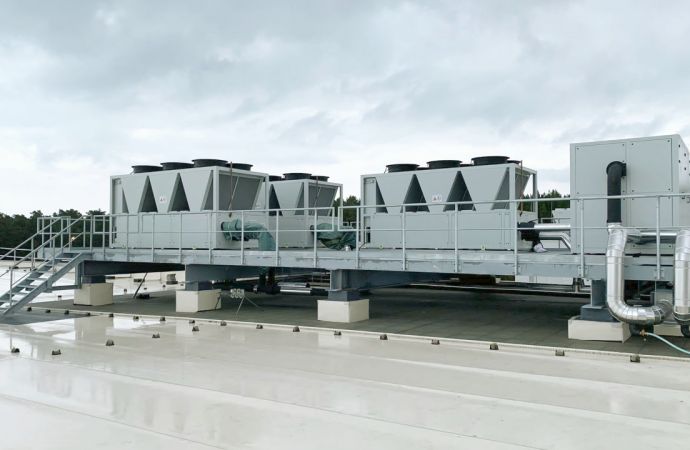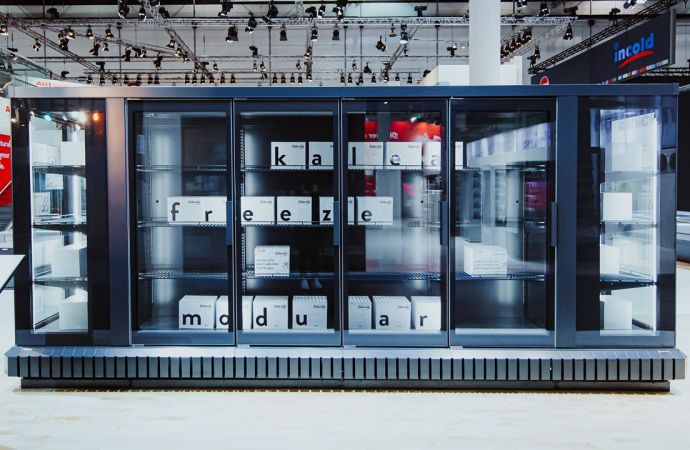Through installations, training and industry initiatives, contractor Source Refrigeration – led by its chief engineer Bryan Beitler – is helping food retailers and others transition to natural refrigerants.

Bryan Beitler, Source Refrigeration & HVAC
On July 25, 2012, Supervalu unveiled the first all-natural-refrigerant system in the U.S. at a remodeled store in Carpinteria, Calif.
The cascade refrigeration system employs ammonia on the rooftop and CO2 in the store. This was the first time that only ammonia and CO2 were used in a U.S. supermarket’s refrigeration system (the first all-CO2 transcritical system would come a year later); today there are three more U.S. stores with this cascade system.
Now owned by Albertsons, the Carpinteria store represented a turning point for natural refrigerants in the U.S. Many parties played important roles in this installation, including Supervalu and the manufacturers Hillphoenix (provider of the CO2 rack) and Mayekawa (supplier of the ammonia rack).
Another key player was the main contractor for the project, Source Refrigeration & HVAC, which participated in the design, installation and maintenance of the technology. (Source no longer services the store.) It was a task no U.S contractor had ever tackled before at a supermarket.
“We selected Source because of their commitment to training a workforce for next-generation refrigeration and because of their executive-level commitment to being involved with, and accountable for, the success of this history-making project,” said Richard Heath, at the time Supervalu’s director of energy innovations and projects.
At that time, Source, based in Anaheim, Calif., had just begun to install CO2 refrigeration (mostly pumped systems using HFCs on the high side). Since then, Source has gone on to deploy many more CO2 systems, including cascade and transcritical, for a total exceeding 50 – likely the most of any U.S. contractor. As Heath noted, the company has committed itself to teaching its technicians about the art and science of natural refrigerants, staking out an industry-leading position in the training arena.
The individual who has orchestrated Source’s natural refrigerant activities is Bryan Beitler, its vice president and chief engineer; he has more than 35 years of experience in refrigeration and HVAC design, sales, energy optimization and operations support, mostly focused on food retail, cold storage and process refrigeration. His myriad roles at Source range from design to training. “As a senior manager, I wear lots of hats,” he said. His 40 contractor’s licenses allow Source to operate in its far-flung footprint.
Beitler serves in several extracurricular roles as well, including CEO of the North American Sustainable Refrigeration Council (NASRC), which is helping drive adoption of natural refrigerants in supermarkets.
Source and Beitler exemplify the pivotal, multi-faceted role that a contractor can play in facilitating the transition to natural refrigerant systems.
According to its website, Source’s retail customers include some of the biggest names in the grocery business, such as Whole Foods Market, Albertsons, Kroger, Walmart, 7-Eleven, Target and H.E. Butt Grocery. The contractor also serves convenience stores, restaurant chains, dollar stores, cold-storage warehouses, telecom, schools, and pharmaceutical companies. Source recently quoted a transcritical CO2 system to replace an R22 unit for a California pharmaceutical company.
In natural refrigerant projects, Source gets involved, as it did at the Carpinteria store, in all aspects, beginning at the engineering/design stage, and moving onto installation, service and optimization. “We design what the customer wants,” said Beitler, and then an OEM produces the rack.
Source’s CO2 installations are “scattered around our footprint,” said Beitler, including an early transcritical system in a Tulsa, Okla., store, which uses an adiabatic gas cooler to operate efficiently in the warm southern climate.
So, our message is, it’s coming, let’s make sure you’re prepared for it."
– Bryan Beitler, Source Refrigeration & HVAC
Beitler is seeing early adopters install natural refrigerants in one or two stores, and then “evaluate it for a period,” he said. “Some move forward with a program.” Other retailers are “hanging back and letting others do the R&D.”
Still, Beitler regards natural refrigerants as a growing trend in North America. “It’s gotten the attention of the industry,” he said. And the momentum is such that he does not see a retreat following the Trump Administration’s decision to exit the Paris accord on climate change.
In a blog that he wrote for NASRC last year, Beitler identified the “consultative role” that contractors can play, “lending support, knowledge and advice to their retail store customers, many of whom are on the fence about natural refrigerants.” Retailers who lack an in-house engineering capacity, he told Accelerate America, “might rely on us to steer them in the right direction or provide options.”
While some retailers may not be ready for natural refrigerant technology, “we have to bring it to their attention,” he said. In California, where the Air Resources Board is moving toward putting a GWP limit of 150 on new refrigeration systems, retailers may have no choice but to use natural refrigerants. “So, our message is, it’s coming, let’s make sure you’re prepared for it. Do a test store, shake out the bugs, and get comfortable with it.”
Making training count
Technician training “is a seven-figure expense every year” for Source, so “we want to make it count,” said Beitler. Of course, it goes well beyond natural refrigerants, since 90% of what Source services still uses synthetic refrigerants. But, as a relatively new technology, natural refrigerants represent a significant part of the program, given the need for hands-on training in this technology.
At its Anaheim headquarters, Source opened its biggest training facility in 2013, a 12,000-sq.ft. Technical Training Center that was relocated from Chino, Calif. The company has another training center in Houston, and is completing build-out of a third in Jacksonville, Fla., to support the development of regionalized training programs.
Source has written its own technical training curriculum, with seven levels of certification for service technicians and another four for installation technicians. In Anaheim, Source typically trains mid- through upper-level technicians, while lower levels are done on a regional basis. Junior technicians may start out at a convenience store and work their way up to a supermarket. “I’m not sure they’re into natural refrigerants at the lower levels, but it’s probably going to have to find its way there,” said Beitler.
Source’s training season runs from late September/early October through April or May, considered the “off season” when the demand for technicians is likely to be lower than during the hot summer months.
The upcoming training season's calendar includes more than 40 week-long courses in Anaheim alone. Typically each course requires a full week of training. "That's a big commitment but we believe it's important to ensure our technicians receive development by participating in what we consider to be one of the best training programs of its kind in the country." said Beitler.
The Anaheim facility comprises a full grocery store set-up, featuring low-temperature and medium-temperature remote cases, walk-in coolers, self-contained cases, controls and an equipment room with operating racks.
Source recently installed, and is soon to start operating, a subcritical CO2 refrigeration system – used equipment from an abandoned store – for the grocery training area. It employs CO2 in low-temperature DX and pumped medium-temperature applications, in concert with a synthetic high-side refrigerant to condense the CO2. Technicians will be trained on how to install, start up and operate the system, which includes a liquid pump that not too many technicians are familiar with; the system may also be used as a guide to transcritical operations. “There are a variety of opportunities we hope to put in front of them,” said Beitler.
Propane education, Beitler noted, is an area that requires further attention at Source. “We have an educational push to dig into propane systems and get our technicians additional training. This fall it will be a bigger part of the curriculum. It’s showing up everywhere, so we have to be ready for it.”
To that end, Source is securing self-contained propane equipment for its training center in Anaheim. The contractor is also partnering with True Manufacturing, a self-contained propane case supplier that offers online classes.
The complete article on Source Refrigeration can be found in the August 2017 issue of Accelerate America.
Related stories



